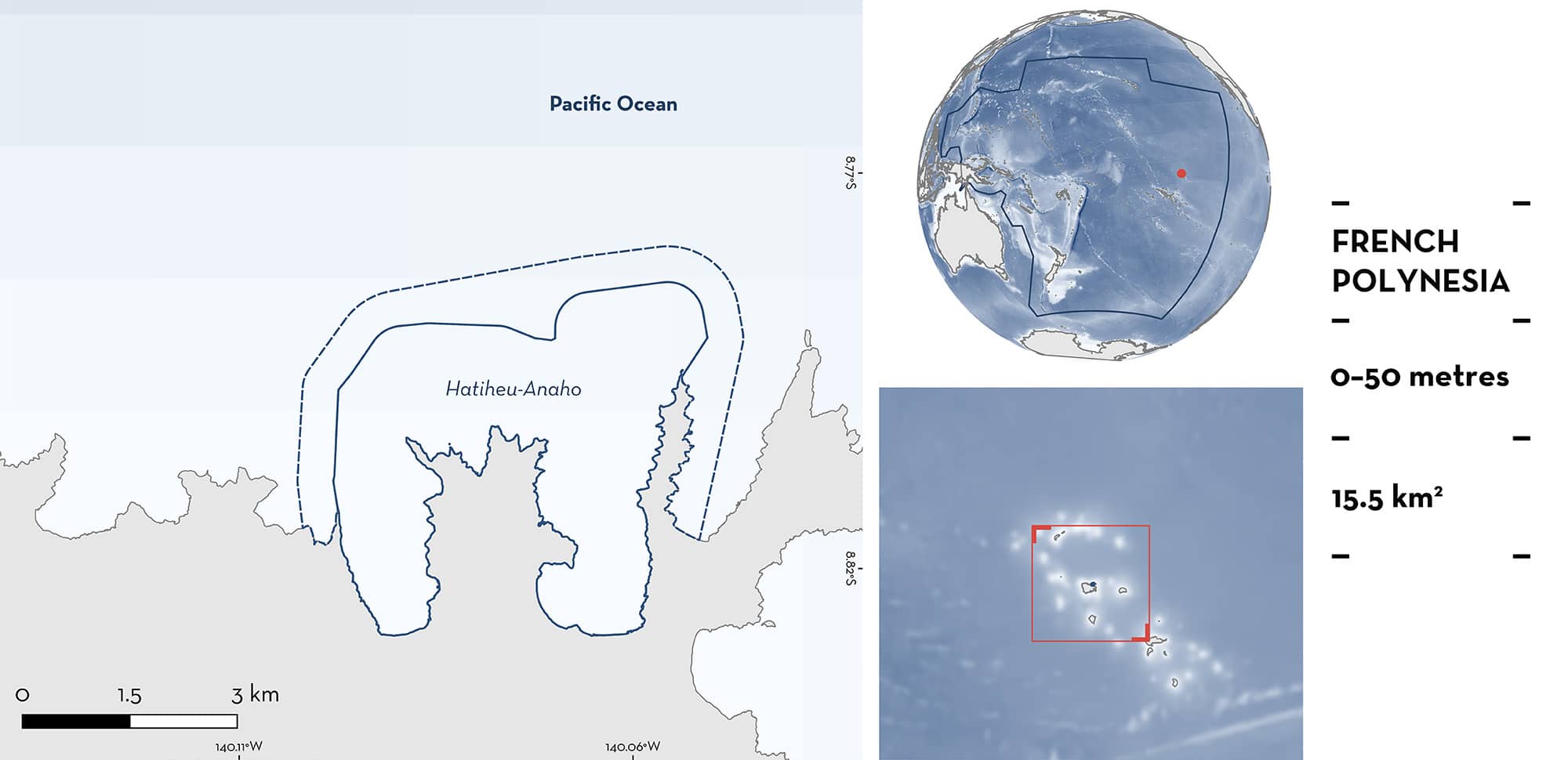ISRA FACTSHEETS
ISRA FACTSHEETS
NEW ZEALAND & PACIFIC ISLANDS REGION
Hatiheu-Anaho
Summary
Hatiheu-Anaho is located on the northeastern coast of Nuku Hiva in the Marquesas Islands in French Polynesia. The area encompasses the bays of Hatiheu and Anaho and is characterised by coral reefs, sandy, and rocky substrates. The area is influenced by the South Equatorial Current and the Equatorial Undercurrent. The area overlaps the Marquesas Marine Key Biodiversity Area. Within this area there are: threatened species and feeding areas (Reef Manta Ray Mobula alfredi).
Download factsheet
Hatiheu-Anaho
DESCRIPTION OF HABITAT
Hatiheu-Anaho is located on the northeastern coast of Nuku Hiva in the Marquesas Islands in French Polynesia. The area encompasses the bays of Hatiheu and Anaho shielded from the prevailing trade winds due to its unique topography. Hatiheu-Anaho hosts one of only two bio constructed reef communities in the Marquesas archipelago and includes both sandy and rocky substrates (Andréfouët et al. 2014). The area is influenced by the South Equatorial Current and the Equatorial Undercurrent playing an indirect role through upwelling, with increased productivity driven by the Island Mass Effect and the island’s unique bathymetry (Agence des Aires Marines Protégées 2016).
This Important Shark and Ray Area overlaps with the Marquesas Marin Key Biodiversity Area (KBA; KBA 2024).
This Important Shark and Ray Area is benthopelagic and is delineated from inshore and surface waters (0 m) to 50 m based on the bathymetry of the area and observations of the Qualifying Species.
CRITERION A
VULNERABILITY
One Qualifying Species considered threatened with extinction according to the IUCN Red List of Threatened Species regularly occurs in the area. This is the Vulnerable Reef Manta Ray (Marshall et al. 2022).
CRITERION C
SUB-CRITERION C2 – FEEDING AREAS
Hatiheu-Anaho is an important feeding area for one ray species.
Between 2019–2023, snorkelling and dive surveys using photo-identification (n = 13) and citizen science observations were conducted in the area, resulting in a total of 44 sightings of 42 identified Reef Manta Rays (Carpentier et al. 2019; M Santangelo pers. obs. 2019; French Polynesia Manta Project unpubl. data 2024). The survey effort spanned 2019 (number of surveys, n = 1), 2020 (n = 1), 2021 (n = 1), 2022 (n = 2), and 2023 (n = 8) (French Polynesia Manta Project unpubl. data 2024). Due to the remoteness of the area, surveys were limited and only conducted in February, May, and August (M Santangelo pers. obs. 2023). Five feeding aggregations of Reef Manta Rays with up to 23 individuals (mean = 14) were recorded in the area in 2019 (n = number of aggregations, n = 1), 2022 (n = 1), 2023 (n = 3) (French Polynesia Manta Project unpubl. data 2024). Feeding was the most frequently observed behaviour, accounting for 57% of all sightings (M Santangelo pers. obs. 2023; French Polynesia Manta Project unpubl. data 2024). Of the 42 individuals identified in this area, 23 were observed feeding, representing 14% of the Nuku Hiva identified population (n = 168) (French Polynesia Manta Project unpubl. data 2024). This area ranks as the fifth highest in biomass within the highly productive Marquesas Archipelago (Agence des Aires Marines Protégées 2016). The observed feeding aggregations are likely linked to zooplankton blooms in the region due to the interaction of surface currents, including both Ekman and geostrophic currents, and the bathymetry of the island (Martinez & Maamaatuaiahutapu 2004).
A courtship event was recorded in February 2023 involving eight individuals (Carpentier 2023). Furthermore, surveys interviews among the local population in the island support regular observation of Manta Rays year-round (although identification at species level was not provided) (Agence des Aires Marines Protégées 2016; A Carpentier pers. obs. 2024).
Download factsheet
SUBMIT A REQUEST
ISRA SPATIAL LAYER REQUEST
To make a request to download the ISRA Layer in either a GIS compatible Shapefile (.shp) or Google Earth compatible Keyhole Markup Language Zipped file (.kmz) please complete the following form. We will review your request and send the download details to you. We will endeavor to send you the requested files as soon as we can. However, please note that this is not an automated process, and before requests are responded to, they undergo internal review and authorization. As such, requests normally take 5–10 working days to process.
Should you have questions about the data or process, please do not hesitate to contact us.


